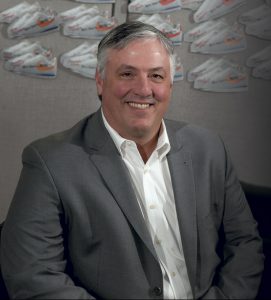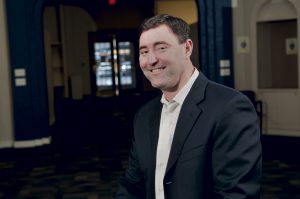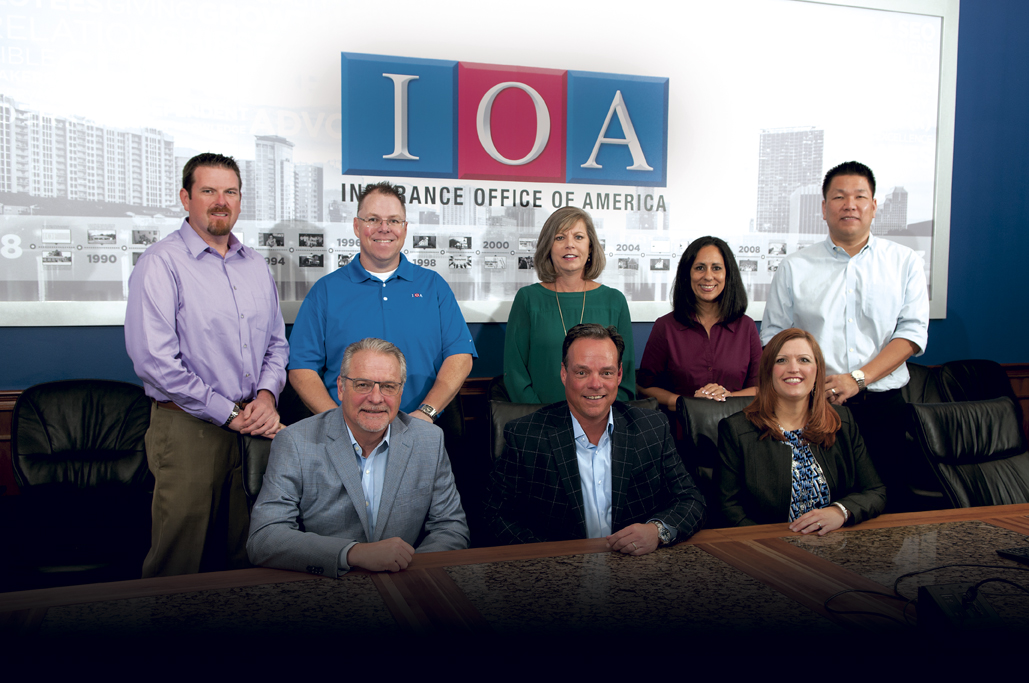AGENCY OF THE MONTH
Florida agency becomes national powerhouse
If you build it, they will come,” apparently does not just apply to baseball. In 1988, Valli and John Ritenour started Insurance Office of America (IOA), Longwood, Florida, and built it as a place that would attract clients and employees, including top-performing agents—a place that they would never want to leave because it provided some of the best producer contracts in the business, along with state-of-the-art services and coverages.

—Jeff Lagos
President
As Jeff Lagos, CPCU, agency president, explains, “Our founders wanted to create an agency for agents, rather than for the owners. We have both W-2 and 1099 producers who receive commissions as high as 57%, and that’s on both new business and renewals, because retention of current clients is just as important as developing new relationships.”
CEO Heath Ritenour, Valli and John’s son, adds, “To show how important retention is to us—and we have a retention rate that is among the highest in the business—we continue to pay our producers for six years after they retire, based on retention. We understand that our producers have a special relationship with their clients, and we want that to continue.
“These clients are their friends,” he adds. “So we don’t just take an agent’s book when he or she leaves and give it to someone else. The retiring agent finds the replacement for the book and introduces that new person to the clients, oftentimes remaining an active partner with the replacement, meeting with the clients and helping the transition.”
Heath adds, “We also allow every producer the opportunity to buy stock. And all of them have equity in their business. This system of compensation has created one of the win-win situations so often mentioned, where not only does our retention remain high, but we have built-in perpetuation. These are two key ingredients in maintaining a healthy and growing insurance agency.”
The concept certainly seems to be working. Today, IOA’s 1,000-plus employees, including more than 300 producers, serve clients from 50 or so offices around the country. The firm finished last year with $181 million in insurance revenue.
The next step
IOA recognized that a producer contract could be duplicated. “We had to make certain that we had the best tools and back office to support our producers’ efforts,” Jeff says. “The commission is the icing on the cake.
“When I got into the business,” he continues, “the agent with the cheapest policy won the business. But today, there are fewer agencies out there; they mostly represent the same companies and offer similar prices and coverage. We had to find a way to differentiate ourselves, to develop a completely different value proposition that didn’t just offer the best coverage, but also ways to improve each client’s bottom line through risk management and risk mitigation.”

—Rob Motley
Regional President
Jeff remembers the beginnings of this approach 22 years ago when “we purchased software that analyzed the mod of the client and allowed us to work with them to positively impact their workers comp premiums. We also noticed that claims were not always handled well and hired insurance adjusters—we call them claim advocates—to work for us to advocate for our clients whenever there is a claim.”
The agency built on these developments by investing in a learning management system that includes safety training, which tests client employees for understanding and includes report capabilities. The agency also developed a proprietary claims portal that connects with their insurers, so both the claims advocates at the agency and the insurance company receive the first notice of loss simultaneously.
“This allowed us to move from a reactive mode to a more proactive approach with claims,” Jeff points out. “But we really wanted to become proactive regarding every aspect of the risks faced by our clients.
“Every agency talks about differentiation. We wanted to stand out from the crowd and do something really different. That’s when five of our agents decided to attend a Purple Cow seminar and find out what we could do that would make us purple in a herd of brown.” The concept comes from, Purple Cow: Transform Your Business by Being Remarkable, in which author Seth Godin says the key to success is to stand out—to be purple cows among normal-colored ones.
Regional President Robert Motley was one of those five agents. “I was probably the weakest of the five of us, so they appointed me the leader,” Rob says with a chuckle. “There were 15 different agencies represented from across the country, Canada and Mexico. We all started out by giving our ‘elevator speech’ and we all sounded the same. That’s when we realized that, if we were going to stand out, we needed to ‘up’ our game.”
The seminar opened the agents’ eyes to a new, more complete approach to client service. It had to become a continuous process that started before the placement of coverage and picked up after the client had signed on with the agency. The concept was simple: Interview the client’s management and employees to determine their complete risk profile, and then create a strategic roadmap designed specifically for that client that would improve their handling of risk and reduce the cost of risk transfer.
When he got back to the office, Rob found that he had the support of his partners to implement the concept. A couple of years later, with an investment in software development that exceeded $1 million, IOA created RiskScore®. The program was developed in partnership with the agency’s clients and the insurance companies with which it had relationships. This helped it receive the buy-in necessary from those two key parties to the risk transfer transaction. The end result, Rob says, was preferred terms for clients and, because clients elevated their risk management and safety culture, better risks for carrier partners.
Amy Wacker, assistant vice president of client engagement, says that RiskScore had its beginnings after one of the agents interviewed people at customer businesses for three days to find out how they dealt with problems. “We wanted to take a deep dive into company behaviors,” she says. “We then sent this information to C-suite-type individuals, as well as to people involved in hiring and firing in safety management to get their reactions. From this feedback, we began to develop an automated process that ultimately evolved into RiskScore.
“The process identified a three-step approach:
“1. Identify the strengths and weaknesses of the customer,
“2. Develop solutions and implementations for that customer, backed up by our risk services team of 17 individuals here at the agency, who would work with the customer on the steps necessary to improve their risk profile and reduce claims frequency and severity, and
“3. Present our insurance carriers with the customer’s RiskScore, in order to get better terms and conditions in the policy.”
Changing the relationship
“This gives the producer the ability to call on a client or prospect and have a different conversation,” Rob points out. “When I meet with prospects, I’m not simply asking if I can quote their insurance; I talk about our RiskScore process, pointing out how it has benefited our current clients by reducing their risk and attracting preferred terms in the marketplace.”
The agency actually developed a survey that takes the client about 15 minutes to complete and provides immediate results to the client and producer via technology. “Through this process,” Rob notes, “we are able to gain more information about the client than their incumbent agent has. As a result, we are able to move into a consultative mode, where we provide techniques and practices that can help prospects improve their risk management procedures and lower their overall insurance costs.”
He points out that IOA originally worked with 31 different insurance company underwriting teams in RiskScore development. “They actually helped us create the platform based on what they needed to see in order to recognize insureds as ‘best in class.’” In essence, RiskScore for them has mirrored the role of credit scores for lending institutions.
Has the program been successful? “Absolutely,” he says. “With current clients, helping increase their score results in better terms and conditions. For prospects that agree to adopt the recommendations developed by RiskScore, they too will enjoy an opportunity to see lower total insurance costs. In fact, we have seen underwriters who declined coverage reverse their decision and offer it when prospects agreed to adopt the RiskScore recommendations.”
Rob concludes, “This goes right back to being the Purple Cow. We are recognized as partners and trusted advisors with our clients, and that results in better retention and more referrals. My client base has doubled since the roll out of RiskScore. It is amazing the opportunities that have opened up, and the ability to qualify and capitalize those opportunities has been a blessing.”

—Heath Ritenour
CEO
Heath wraps it up by noting that “RiskScore was developed around what our carriers look for in order for a particular business to be considered a best-in-class risk. We can show the client where they stand in relation to their peers in their industry, and what they need to become the best. We get into every aspect of the business: hiring, claims handling, risk management, safety, wellness, and more, and we show both the client and the insurance company where the improvements are being made.”
Heath says, “We offer a detailed training program for those producers that want to utilize RiskScore as part of their selling process.” To which Rob adds: “That’s a key point. One of the things that makes IOA such a great place to work is the freedom. Producers have freedom. They don’t have to be trained in RiskScore.
“This freedom creates a great environment, where you can achieve a good life/work balance,” Rob says. “And, because of that, there’s a camaraderie that is a byproduct of our mutual success. We don’t compete with each other. In fact, the opposite is true.
“Producers from around the country will stop what they are doing to help a fellow producer from another office in another region,” he adds. “It blows me away and I am happy to be a part of it. We really are a team whose mission is to be the best we can be for our clients.”
More to come
“We’re not resting on our laurels,” says Jeff. “We have three committees that are holistic in how they look at things. Our P-C and benefits committees look at what we need to do to remain the best in the marketplace in order to stay ahead of the curve. But most important, we have a client engagement committee that includes people from all across the country. They look at the agency’s long-term strategy in terms of emerging trends affecting the risk-transfer marketplace. This helps us continue to provide our clients and our insurance company partners with the most effective tools and strategies for risk management and risk mitigation.”
IOA has built an agency that focuses on creating a better life for its employees, producers, clients and insurance company partners. Rough Notes is proud to recognize it as our Agency of the Month.
By Dennis H. Pillsbury





